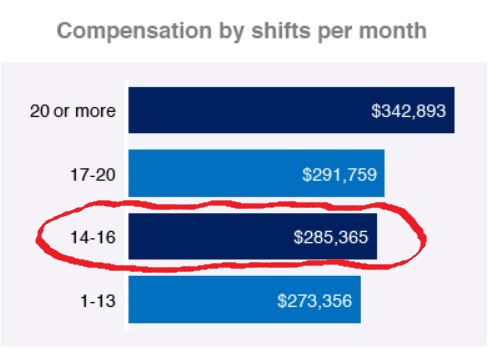

Vlad Dzhashi, MD
Bonus: Hospitalist Gig Checklist – Ask RIGHT questions, Make MORE money!
Let’s face it, if you are an internal medicine or family medicine physician, you are among the lowest paid doctors in the U.S. You made the conscious choice to go to the IM or FM residency, and I’m sure you were passionate about it.
However, sometime after the start of your first job, the excitement of the first few paychecks starts to lessen. You realize that although you earn an above average wage, you do not feel rich or even well off.
That becomes especially evident if you live in any large metro area where the cost of living continues to rise.
You soon realize that with your current income, it will take years, if not decades, to pay off your medical school debt. Plus, you have a family to support, hobbies to enjoy, and dreams to fulfill.
With an average primary care or hospitalist salary, these dreams are not easy to achieve. That’s why you need to leverage your highly sought after clinician skills to maximize the financial gains as well as optimize your work time.
Here are the seven rules that will take you from average to highest paid!
Rule 1 WORK FULL-TIME LOCUM TENENS
The best way to leverage your skills is to become a full-time locum tenens hospitalist. A locums hospitalist salary is substantially more as compared to permanent employment as it’s one of the most flexible physician jobs.
Just by switching to a full-time locum tenens position and working the same hours and numbers of shifts, you will make at least 20 percent more than your colleagues.
Most of my locum colleagues make much more than that, and some make 70 to 100 percent above the average hospitalist salary. Just consider the long-term gain from this approach!
Have you heard the advice to consider the fellowship for a more lucrative specialty, let’s say cardiology or GI, if you want to make significantly more than an average hospitalist? That’s certainly advice I’ve been given.
Well, what you might not have realized is that generally speaking, these specialties must work a lot, pretty much every day, with one or two weekends off a month at most.
We’re also talking about regular night or 24-hour calls, very busy clinics, plus at least some administrative meetings and obligations.
Think about how much you can make as a hospitalist working 25 shifts a month. You’re looking at income very close to, if not more than, the average cardiologist or GI physician would make.
And this is without spending at least three years of fellowship, going deeper into student debt, and not being able to enjoy life due to lack of time and money.
Here’s another consideration: flexibility. Do cardiologists or Gastroenterologists have the same flexibility as locum hospitalists? Not even close! As a locum hospitalist, it’s so easy to cut back on the number of shifts, in case you want to work on a side project or enjoy two months of mini-retirement while traveling all over the world.
I don’t know of any other way that internal or family medicine physicians can make more than that while also retaining a high degree of independence and unparalleled flexibility.
Have you noticed that one’s life and career always seem to be plagued with the constant conflict that revolves around money and time? For example, either you have no money to spend or you have no time to spend your money? The problem is how to get both at the same time. Locum tenens allows you to do just that!
One argument I’ve heard against working locum is that you have to travel a lot, and some people don’t want to do that. But travel is not necessary. You can minimize or even completely eliminate the need to travel as a per diem hospitalist.
Rule 2 NEGOTIATE
To get the highest possible pay, you must negotiate your pay rate and refuse to accept a below market rate. Unfortunately, I’ve seen a lot of physicians starting locum tenens work who don’t negotiate, and so, they sell themselves short.
Keep in mind that every $10/hr pay rate increase will produce $20K of extra income annually. Use this locum tenens salary calculator to play with the numbers and see for yourself.
Negotiation seems to come more naturally to some people than to others, but it’s not that difficult and anyone can do it; you just need to know how to negotiate locum rates. Just remember, as a physician, your skills are in high demand and you must be paid adequately for your hard work.
Interestingly enough, pay isn’t the only thing you can negotiate. You can also negotiate accommodations and travel arrangements. You may be surprised, but a few times, I even negotiated my daily patient census!
Want to learn how to screen new locums gigs properly to avoid unpleasant surprises and negotiate the highest possible pay rate to make tens of thousands of $ more per year? Click Here to download the Hospitalist Gig Checklist I’ve created.
Rule 3 PICK THE RIGHT LOCATION
Locum tenens allows you to work pretty much anywhere in the U.S. and even beyond, so it’s crucial to focus on the right location for you.
Two important considerations are pay rate and taxes.
Based on my experience, you can expect higher pay, on average, in the South and Midwest as compared to the Northeast. I’ve seen a significant difference between facilities in metro areas and those in rural/semi-rural settings.
The pay gap may even exist within the same state. For example, as a rule, you will get higher pay in Northern California than you would in Southern California.
Working in low or no income tax states can make a substantial difference in your income. No income tax states are AK, FL, NV, TN, TX, WY, and SD. Examples of low income tax states are IN, ND, WA and PA.
One caveat to that is the tax law can be complicated and they change. For example, self-employed physicians in Washington are taxed 1.6 percent, even though the state has no income tax for employed individuals. If you work in multiple states, the issue of reciprocity and tax residence also comes into play, which leads me to the next rule.
Rule 4 BE SMART WITH YOUR TAXES – GET A CPA!
Do you know this guy?
Who cares if you are on a hospitalist $500k a year salary a year and most of it goes to taxes? It only makes Uncle Sam happier, right?
You work hard to earn your money, and you want to keep what you’ve earned (use this locum tax calculator to estimate your tax burden).
That’s why it’s important to hire a CPA who can show you how to minimize your tax burden.
I prefer personal references as the best way to pick from accountants for locum doctors. Before you hire an accountant, make sure the person has experience with self-employed professionals.
For more useful tips on how to choose a quality accountant, check out this resource.
Rule 5 HAVE FUN!
You cannot become the highest paid hospitalist if you constantly work in a super stressful environment. A lot of things can make the facility difficult to work at, e.g. inadequate subspecialty support or crappy EMR, among others.
On the other hand, if you enjoy your locum tenens hospital, you’ll be able to pick up a few extra shifts a month and get a fat paycheck, and that’s even if the pay rate there is a little less.
While there’s no ideal hospital, you can always find one where things are reasonably organized and the overall culture is healthy.
Another point to consider is what you enjoy doing after work. If you crave sunshine and the beach, like I do during gloomy Seattle winters, then California, Florida, or Hawaii might be a good fit for you.
Do you love skiing? If you do, there’s probably no place better than Utah or Colorado.
Just remember to start your locum tenens licensing application at least a few months in advance.
If being close to your family is important, then find locum shifts within a commutable distance from home.
And even if you are couch potato and just enjoy watching TV in the hotel room after work, be sure you stay in decent locum tenens housing.
Whatever makes you tick, choose accordingly.
A good indicator that you are in the right spot is your overall energy level and feeling of well-being. So if you wake up every morning feeling good and even the most obnoxious drug-seeking patient doesn’t stress you out, make sure you work at that hospital and location as long as you can.
Rule 6 BE MINDFUL OF BURNOUT
Are you wondering why I’m talking about burnout? You might be asking, “How about all the so-called best locum tenens companies promoting the idea that locum tenens is a cure for burnout?’
Well, the truth is, you can burn out working locum tenens, too.
Burnout is tricky because it can sneak up on you. So pay attention to how you feel.
Early signs for me were feeling down without an apparent reason, being cranky, feeling annoyed, and being disturbed by minor things, like an RN requesting a Dulcolax suppository order at 2:00 a.m. (Ok., ok. That one doesn’t count.)
When burnout sneaked up on me, I took a break for a few weeks and had to rethink my long-term strategy. I reassessed how many shifts I was actually comfortable working, how close to each other I scheduled them, and how much I traveled. After that, I completely switched to the locations I would enjoy the most.
Good remedies that helped me to fight burnout were regular exercise, spending time outdoors, and tweaking my diet. When working away from home, I find that socializing with my new colleagues also helps a lot.
I know it’s tempting to schedule 20 plus shifts a month to make lots of cash in a short period of time. However, you should treat your locum tenens career like a marathon and not a sprint. Create the schedule that gives you the highest yield long-term, while also preserving your sanity and well-being!
Rule 7 CHECK OUT THELOCUMGUY.COM!
Last but not least, check out my website, especially if you are new to the locum tenens world. I update the site on a regular basis and share everything I know, so you can find lots of useful information here.
- Jumpstart your Locums Career!
- Sign up for my coaching to access:

- Top Gigs
- Top Pay
- Unique resources
- No stress

- Jumpstart your Locums Career!
- Sign up for my coaching to access:
- Top Gigs
- Top Pay
- Unique resources
- No stress
Now let’s look at the current hospital medicine salary in the US.
Hospital salary guide: how much do hospitalists make?
So…how much does a hospitalist make these days?
It depends…
Thank you, Captain Obvious!
Ok, ok…I’ll show you actual hospitalist salary numbers shortly but first, let me explain WHAT it depends on.
🗺️ Region: Lowest salary – Northeast and Highest – Midwest
🎓 Practice settings: Lowest – Academic/University settings
💪 Productivity: how many patients you see daily
🚑 Critical care/ICU coverage: Lowest – Closed ICU, Highest – Open-ICU
⏱️ Type of shifts: Days, Swing, or Nights.
Average hospitalist salary:
According to the most recent Today’s Hospitalist survey, the hospitalist national average salary in the US is $285,365. As you can see below, this is based on 14-16 shifts a month.

Hospitalist salary pay structure:
There are three different models of how hospitalists get paid.
1 – 100% Salary: the pay is based on the number of shifts or hours you work.
This model is simple: you get paid a fixed amount for a set number of shifts. It doesn’t account for how many patients you see and how busy you are.
So, no matter if you are seeing 10 patients or 20 patients a day, you still make the same amount.
2 – Hybrid: Salary AND bonuses/incentives.
With a hybrid model, you have a fixed base salary and you get a bonus which is usually based on quality metrics and work RVUs.
3 – 100% productivity: Salary is based on work RVUs. The more patients you see, the more money you make.
What are the highest paying hospitalist jobs?
Locum tenens would give you the highest pay rate and salary.
Other than locums, working nights would give you more money per hour.
The other option to get the highest paying hospitalist job is to sign up with a private hospitalist group with a 100% productivity compensation. Unlike the hospital-employed model when you get a base salary and a (small) percentage of the billing collections, these guys pocket as high as 90% of work RVUs.
I’ve talked to a few hospitalists working for private groups and are making $500K+ a year doing only 15 shifts a month, but they see 25+ patients a day.
Because of a very high patient volume, they rely heavily on consultants even for little things, for example, cardiology consult for sinus tachycardia or infectious disease consult for uncomplicated UTI or pneumonia.
And what about a hospitalist starting salary?
A hospitalist physician starting salary paid to the residency graduates may be different from that of an experienced hospitalist.
The difference can be as high as 20% and can take the form of a lower base salary or lower percentage of productivity (work RVUs) you get as a bonus.
Having said that, there are a lot of hospitalist programs with no difference in pay between new and experienced docs.
Hospitalist nocturnist salary
So if you don’t mind or even enjoy working nights, you are in for a prize: nocturnist hospitalist salary is typically higher than that of day hospitalists with a 20-30% pay differential.
Having said that, it comes in two different forms.
1 – Nocturinists work 7 on/7 off and make 20-30% more per year ($330K+ year).
Or
2 – Nocturnists work 7 days on and 14 days off and make the same salary as regular hospitalists.
The other good news for nocturnists is that a lot of times their shifts are shorter, e.g. 10 or even 8-hour shifts, hence your hourly pay can be as high as $230/hr.
Internal medicine hospitalist salary vs Family medicine hospitalist salary
There’s a common misconception that a family medicine hospitalist salary is lower than internal medicine hospitalist salary.
In my experience, this is not true and the average salary would be the same.
One difference, however, is that some hospitalist programs exclusively employ internal medicine hospitalists on the grounds that Internal medicine doctors have better inpatient training.
Other programs would only hire family medicine doctors with a few years of hosptialists experience.
What about locum tenens?
As mentioned above locum tenens hospitalist salary will be at least 20% higher than that of a permanent hospitalist.
Hospitalist salaries: my conclusion
To be the highest paid hospitalist, you need to work locum tenens long term, negotiate your pay rate aggressively, and pick the right location that pays well and where you enjoy working, ideally with no state tax.





Solid advice. Never done locums work myself but had plenty of colleagues that have and enjoy it. I am Internal Medicine as well and I do outpatient primary care. I have wondered if more physicians across all specialties will move to independent contractor status. In our current environment where everything is being consolidated, it represents a way for us to maintain some semblance of control over our careers. What do you think?
I’ve got more freedom compared to when I was a full time employed hospitalist. I’ve also got greater control over my schedule and income.
In fact, the current trend is that more and more docs work locum tenens.
Thankyou, one question what do you think of the constant credentialing each time you apply for a locums gig…that’s something that makes me not want to do it
Chris,
I know what you are saying. Credentialing process is indeed very painful at times.
But I’ve learned how to deal with it and waste as little time as possible.
Here are few tips, some of them I’ve described here – https://www.mdmag.com/physicians-money-digest/lifestyle/locum-tenens-smartphone-apps.
1 – Create your online file storage – you can use any cloud storage, most of them are free, i.e. google drive, iCloud, Dropbox etc.
2 – Invest some time upfront in scanning all the important documents – medical school diploma, residency certificate, state licenses, immunization records etc.
3 – Create a file (e.g. Excel spreadsheet) listing 3-5 colleagues who you’ll use for reference purposes. Make sure you list their names, emails, phone numbers and dates when you first worked together.
4 – Create another file listing all the hospitals you’ve worked at including the dates when you started and worked there last. Make sure you update it once a year.
5 – Attach all the files to your hospital application and email to the credentialing specialist.
6 – Ask the hospital credentialing person to fill in as much info as possible based on the documents you’ve provided.
Sometimes they get lazy but it’s their responsibility to assist you with the credentialing process so remind them politely of this fact and do not hesitate to push back if you feel they are not helpful.
As you can see, once you’ve created your “credentialing portfolio”, you’ll save tons of time with your next application.
I hope it helps